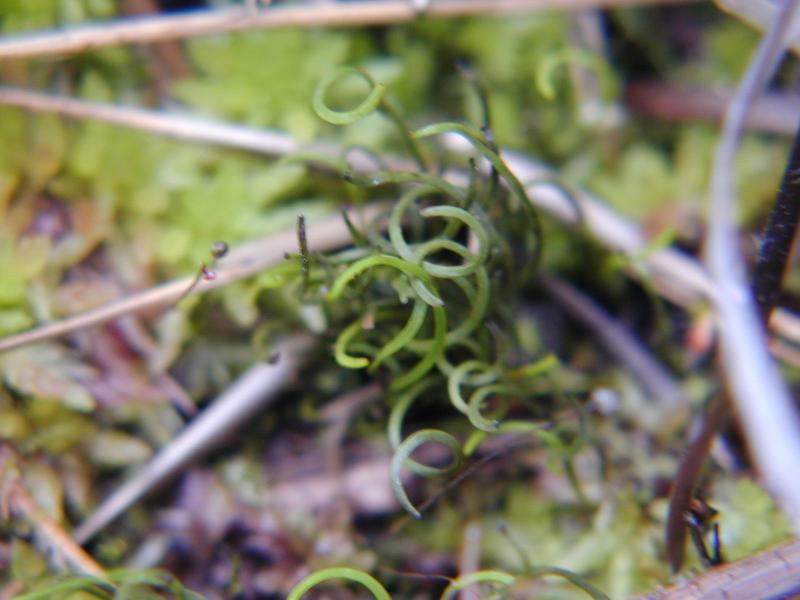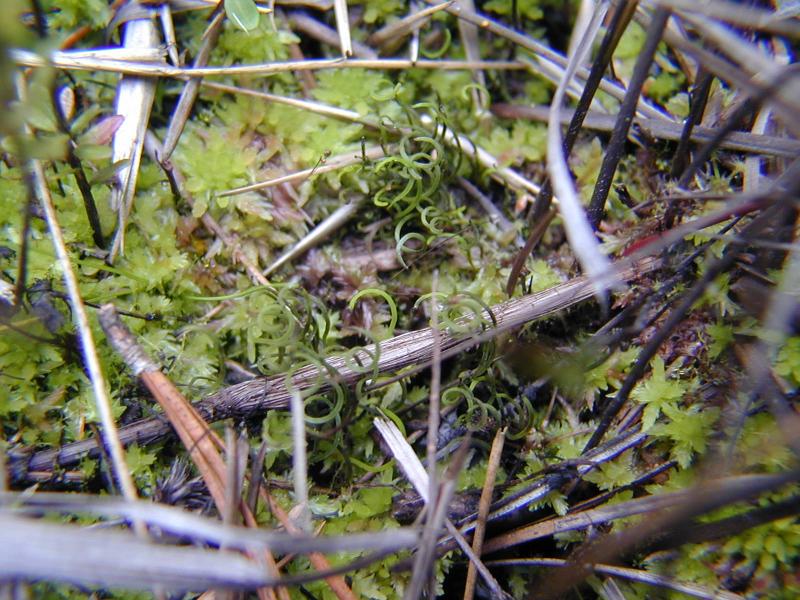Curlygrass Fern
Schizaea pusilla Pursh
- Class
- Filicopsida (Ferns)
- Family
- Schizaeaceae (Curly-grass Family)
- State Protection
- Endangered
Listed as Endangered by New York State: in imminent danger of extirpation in New York. For animals, taking, importation, transportation, or possession is prohibited, except under license or permit. For plants, removal or damage without the consent of the landowner is prohibited.
- Federal Protection
- Not Listed
- State Conservation Status Rank
- S1
Critically Imperiled in New York - Especially vulnerable to disappearing from New York due to extreme rarity or other factors; typically 5 or fewer populations or locations in New York, very few individuals, very restricted range, very few remaining acres (or miles of stream), and/or very steep declines.
- Global Conservation Status Rank
- G3G4
Vulnerable globally, or Apparently Secure - At moderate risk of extinction, with relatively few populations or locations in the world, few individuals, and/or restricted range; or uncommon but not rare globally; may be rare in some parts of its range; possibly some cause for long-term concern due to declines or other factors. More information is needed to assign either G3 or G4.
Summary
Did you know?
It's almost impossible to find this tiny fern without getting down on one's hands and knees, but be careful not to crush it! The genus Schizaea is from the Greek word schizo, to cut, and refers to the fertile frond that is delicately cut and divided (Meehan 1879).
State Ranking Justification
There is only one existing population which is very small and has not been seen in recent years. There are two records, one from 1927 and one from 1929, that need to be rechecked to see if they still exist. One subpopulation of the existing population was destroyed by flooding in the 1980s.
Short-term Trends
The existing population has declined over the last few decades and two older records have not been rediscovered.
Long-term Trends
This plant has always been very rare in New York, and its numbers have been in severe decline over the last 90 years.
Conservation and Management
Threats
Severe drought or severe flooding is a threat to the remaining population as well as too many visits and trampling by people wanting to see the only population in New York.
Conservation Strategies and Management Practices
Visits to the lone remaining site should be restricted .
Research Needs
Monitoring of this population and its response to habitat changes is needed.
Habitat
Habitat
At the only New York population still known to exist, Curlygrass Fern is found on higher sphagnous mounds within a series of low, wet swales. Historically it was also collected from cranberry bogs (New York Natural Heritage Program 2011). On hummocks in bogs or wet grassy places in acid soil (Gleason and Cronquist 1991). Open damp peaty or sandy depressions, sphagnous bogs and low mossy open woods, or even in crevices of ledgy shores, tablelands and lowlands (Fernald 1970).
Associated Ecological Communities
- Coastal plain poor fen*
(guide)
A wetland on the coastal plain fed by somewhat mineral-rich groundwater and slow decomposition rates of plant materials in the wetland (and thus develops peat). Plants are generally growing in peat composed primarily of Sphagnum mosses with some grass-like and woody components.
- Maritime freshwater interdunal swales
(guide)
A mosaic of wetlands that occur in low areas between dunes along the Atlantic coast; the low areas (swales) are formed either by blowouts in the dunes that lower the soil surface to groundwater level, or by the seaward extension of dune fields. Water levels fluctuate seasonally and annually. Sedges and herbs are usually the most abundant types of plants. These wetlands may be quite small (less than 0.25 acre).
- Maritime pitch pine dune woodland*
(guide)
A maritime woodland that occurs on stabilized parabolic dunes. The substrate is wind and wave deposited sand that is usually excessively well-drained and nutrient poor. The community is subject to high winds, sand-blasting, salt spray, and shifting substrate.
* probable association but not confirmed.
Associated Species
- Cladium mariscoides (twig-rush)
- Drosera intermedia (spatulate-leaved sundew)
- Iris prismatica (slender blue iris, slender blue flag)
- Juncus canadensis (Canada rush)
- Sphagnum
- Vaccinium macrocarpon (cranberry)
Range
New York State Distribution
In New York this tiny fern is known only from the Montauk area of Suffolk County, Long Island.
Global Distribution
It is rare throughout its range in Newfoundland, Nova Scotia, and New Brunswick in Canada and in New York, New Jersey, and Delaware in the United States. It is considered exotic in North Carolina.
Identification Comments
General Description
Curlygrass Fern is a small fern which grows low to the ground. The sterile and fertile leaves (fronds) are differently shaped. The sterile fronds are spiraling, curly, and slender (1-5 centimeters long by 0.2-0.3 millimeters wide), and form dense, crowded, somewhat grasslike tufts. The fertile fronds are much longer, slender (barely 0.5 mm wide), and erect (up to 10 centimeters tall). The fertile portion terminal, arranged into 3-8 pairs of crowded, finger-like pinnae 1.5 to 4 millimeters long, with multicellular hairs along their margins (FNA 1997).
Best Life Stage for Proper Identification
Plants with fertile fronds are much more likely to be found, though an astute and lucky observer may identify vegetative plants as well.
Similar Species
Curlygrass Fern is unlike any other fern within the NY flora. Because of its rarity and diminutive size, locating this plant is much more difficult than identifying it.
Best Time to See
Vegetative plants may, with lots of luck, be found from June until fall.
- Vegetative
- Fruiting
The time of year you would expect to find Curlygrass Fern vegetative and fruiting in New York.
Curlygrass Fern Images
Taxonomy
Curlygrass Fern
Schizaea pusilla Pursh
- Kingdom Plantae
- Phylum Filicinophyta
- Class Filicopsida
(Ferns)
- Order Filicales
- Family Schizaeaceae (Curly-grass Family)
- Order Filicales
- Class Filicopsida
(Ferns)
- Phylum Filicinophyta
Additional Common Names
- Curlygrass
Additional Resources
Best Identification Reference
Flora of North America Editorial Committee. 1997. Flora of North America, North of Mexico. Volume 3. Magnoliophyta: Magnoliidae and Hamamelidae.
Other References
Fernald, M.L. 1950. Gray's manual of botany. 8th edition. D. Van Nostrand, New York. 1632 pp.
Gleason, Henry A. and A. Cronquist. 1991. Manual of Vascular Plants of Northeastern United States and Adjacent Canada. The New York Botanical Garden, Bronx, New York. 910 pp.
Holmgren, Noel. 1998. The Illustrated Companion to Gleason and Cronquist's Manual. Illustrations of the Vascular Plants of Northeastern United States and Adjacent Canada. The New York Botanical Garden, Bronx, New York.
Mitchell, Richard S. and Charles J. Sheviak. 1981. Rare Plants of New York State. Bull No. 445. New York State Museum. Univ. of New York. State Ed. Department Albany, NY.
New York Natural Heritage Program. 2010. Biotics database. New York Natural Heritage Program. New York State Department of Environmental Conservation. Albany, NY.
New York Natural Heritage Program. 2024. New York Natural Heritage Program Databases. Albany, NY.
Weldy, T. and D. Werier. 2010. New York flora atlas. [S.M. Landry, K.N. Campbell, and L.D. Mabe (original application development), Florida Center for Community Design and Research http://www.fccdr.usf.edu/. University of South Florida http://www.usf.edu/]. New York Flora Association http://newyork.plantatlas.usf.edu/, Albany, New York
Links
About This Guide
Information for this guide was last updated on: November 7, 2011
Please cite this page as:
New York Natural Heritage Program. 2024.
Online Conservation Guide for
Schizaea pusilla.
Available from: https://guides.nynhp.org/curlygrass-fern/.
Accessed July 26, 2024.

